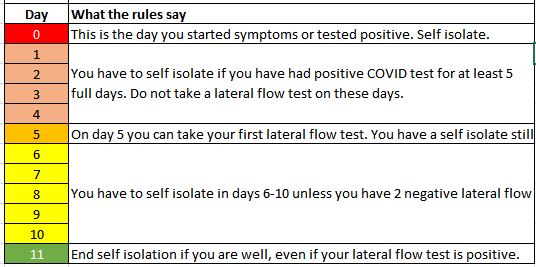COVID Testing - What test do I need?
The rules on what testing I need to do for COVID are really confusing and seem to change every 5 minutes. Here is our quick guide (based on the rules of 07 January 2022). Note that following the withdrawal of the COVID emergency laws, legally you no longer have to self isolate if you have a positive test or test if you have symptoms. However, the guidance remains that you still should, so the wording has been left unchanged to remind you that this remains a significant disease for some people.
The first question to ask is are you doing this as a routine test or do you have symptoms. The quick answer is:
- If you have symptoms, you do need to arrange a PCR.
- If you do not have symptoms, do a lateral flow test
I Have Symptoms
If you have symptoms such as a cough, fever, or loss of taste or smell, you must arrange a PCR as soon as possible. You will need to self isolate until you have the result.
If you choose to take a lateral flow test as well, it can only be a guide. A positive result means that you almost certainly do have COVID; a negative result reduces the likelihood of COVID if you have been boosted, but unfortunately will miss a number of cases of COVID. If your PCR comes back positive you must self isolate, even if your lateral flow test was negative.
I Do Not Have Symptoms
If you do not have symptoms and you are doing this as a regular check before going to work, or meeting other people, then use a lateral flow test.
If your lateral flow test is negative and you have no symptoms, then you are unlikely to have COVID.
If your lateral flow test is positive, you no longer need to arrange a PCR. You must report your lateral flow test result online and self isolate.
There are two exceptions: if you are eligible for the £500 test and trace payment, or you have had a letter from NHS England telling you that you are in the highest risk group and would benefit from the new antiviral treatment, you must arrange a confirmatory PCR if your lateral flow test is positive.
I Have had a Positive Test and Am Self Isolating
After a positive test you must self isolate for at least 5 full days. Note that day 0 is the day that your symptoms began or you had a positive test, so you start counting the days from the day after.
As long as your temperature is back to normal and you feel well in yourself, you can start lateral flow testing on day 5. If you have 2 negative lateral flow tests more than 24 hours apart, you can stop self isolation any time from day 6 onwards. Again so long as you are well in yourself and have no temperature, you can stop self isolation after day 10, even if you have not had a negative lateral flow test (in some people the lateral flow test can continue to be positive for 90 days, similarly the cough can continue)

I Am a Household Contact of Someone with COVID
If you live with someone with COVID-19, you should self isolate from the day that they developed symptoms or tested positive and for the next full 10 days You will not be able to use negative lateral flow tests to end isolation earlier than this.
This self-isolation is not necessary, if any of the following apply:
- you're fully vaccinated – this means 14 days have passed since your final dose of an approved COVID-19 vaccine
- you're under 18 years and 6 months old
- you're taking part or have taken part in an approved COVID-19 vaccine trial
- you're not able to get vaccinated for medical reasons
However, if these apply then you should take a lateral flow test daily for 7 days. If you start to develop symptoms, then you need to arrange a PCR irrespective of what your lateral flow test result is.
Returning to Work
Some employers, such as the NHS, have slightly different rules about returning to work after testing positive or having a significant contact with someone with COVID. You should check with your employer, if they have not already made you aware of their policies, before returning to work.